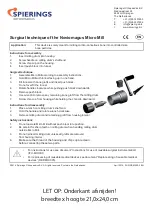
ENGLISH
SAFETY INSTRUCTIONS
Read these instructions carefully before use!
Read these instruction
s carefully before assembly, insta
llation and use. Contact your dealer if you have
any questions concerning the product.
Improper use and lack of maintenance can result in serious injury and/or damage to property. Read all
warnings and instructions carefully before use. Always take basic safety precautions wh
en using
compressed air tools to safeguard against the risk of personal injury.
•
Replace a
ny warning stickers that have become illegible or lost.
•
Only use the tool for its intended purpose.
•
Excessive air
pressure or excessively long oper
ation without a load
shortens tool life and can entail
a risk of personal injury or damage to property.
•
Check
the air hose for wear and protect it from heat and sharp edges. Do not carry the tool by the
air hose.
•
Falling is a common cause of injury and death. Look out for hose bends in your area of movement
and in the work area. Also look out for the part of the
hose that is permanently connected to the
tool.
•
Continuous use and unsuitable working conditions can cause hand injury. Stop using the tool if
your hands become numb o
r start to hurt. Do not resume work until your hands feel normal again.
Seek immediate me
dical assistance if the problem persists.
•
Keep other people at a safe distance from the work area.
Risk of eye or head injury
Risk
Precautions
•
Pne
umatic tools can thr
ow out objects such
as mounting pieces, metal shavings, swarf,
etc., at high speed, which
can cause serious
eye injuries.
•
Always wear safety glasses that meet ANSI
Z87.1 standards and are fitted with si
de
protection.
•
Never leave the too
l unattended when
connected to the compressed air supply.
Always disconnect the air hose when the tool
is not in use.
•
Compressed air can be dangerous. The
compressed air system can cause injury to
soft tissues such as eye
s, ears, etc. Particles
or objects carried by the air
flow can cause
personal injury.
•
For further protection, you should wear an
approved face mask in addition to the eye
protection.
•
Tools or accessories can come loose or
break, and parts can be thrown off, hitting
the user or other indiv
iduals in the work a
rea.
•
Check that all tools and accessories are
fitted correctly.
Fire or explosion hazard
Risk
Precautions
•
Sanding tools with paper or discs, rotating
tools such as drills, percussion tools such as
nai
l guns, staple guns or hammers, as
well
as reciprocati
ng saws and jigsaws, can
generate sparks that can ignite flammable
material.
•
Never use tools near flammable substances
such as petrol, naphtha, solvents, etc.
•
The work area must be clean, well ventilate
d
and free from flammable materials.
•
Never attempt to
power compressed air tools
with oxygen, carbon dioxide or other bottled
gas.
•
Never exceed the nominal maximum
pressure for tools or accessories. This can
cause an explosion resulting in serious
personal injury.
•
The feed pressure of the compressed air
supply must never exceed the maximum
permitted pressure for any accessory.
•
Never connect the tool to a compressed air
supply whose pressure can exceed 13.8 bar.
•
Always check that the compressed air supply
is set to the tool’s rated pressure before
connecting the tool.
















































